Study on Dimensional Stability of Veneer Rice Straw Particleboard
Abstract
:1. Introduction
2. Materials and Methods
2.1. Materials
2.2. Experimental Instruments
3. Experiment Method
3.1. Preparation of Specimens
3.2. Grouping of Specimens
3.3. Determination Method
4. Results and Discussion
4.1. Experimental Results
4.2. Discussion
4.2.1. Effect of the Sanding Thickness of RSP on Dimensional Stability of Veneered RSP
4.2.2. Effect of the Veneer Species on Dimensional Stability of Veneered RSP
4.2.3. Effect of the Moisture Content of RSP on Dimensional Stability of Veneered RSP
4.2.4. Effect of the Glue Spread on Dimensional Stability of Veneered RSP
4.2.5. Effect of the Veneer Thickness on Dimensional Stability of Veneered RSP
5. Conclusions
- According to the analysis of the experimental data, it can be concluded that there were many factors that influence veneered RSP in terms of dimensional stability. Among them, the effect of glue spread was the most significant. The more the glue spread, the worse the dimensional stability of veneered RSP. There was almost no effect of moisture content on dimensional stability of veneered RSP;
- The physical characteristic of shrinkage and bulking of the RSP itself was the essential point of the deformation of veneered RSP;
- By analyzing the reasons for the deformation of the appearance of the RSP specimens, it could be seen that the effect of moisture content on dimensional stability of veneered RSP was the main factor. However, within a reasonable range, an appreciable change of moisture content of RSP would cause a neglectable change in the dimensional stability of veneered RSP.
Author Contributions
Funding
Conflicts of Interest
References
- Wu, Z.H. Manufacturing model of furniture industry in industry 4.0. China For. Prod. Ind. 2016, 43, 6–10. [Google Scholar]
- Xiong, X.Q.; Yuan, Y.Y.; Niu, Y.T.; Zhang, L.T. Research on the Effects of Roughness on the Tactile Properties of Rice Straw Particleboard Surface. Sci. Adv. Mater. 2020, 12, 795–801. [Google Scholar] [CrossRef]
- Chang, L.; Wu, Z.H. Promoting the Competitiveness of China’s Furniture Industry. China Wood Based Panels 2011, 10, 46–48. [Google Scholar]
- Li, P.; Zuo, Y.F.; Wu, Y.Q.; Zhao, X.; Wang, J. Research process on the manufacture and application of straw-based panel. Mater. Rep. 2019, 33, 2624–2630. [Google Scholar]
- Zhang, W.Z. Research production and application of straw board. Guangdong Build. Mater. 2005, 2, 25–27. [Google Scholar]
- Hu, G.B. Review of rice straw based panel development and existent problems in China. China For. Prod. Ind. 2004, 31, 7–10. [Google Scholar]
- Ding, B.Y. Development of straw-based panels industry. China Wood Based Panels 2016, 23, 1–9. [Google Scholar]
- Zheng, F.S.; He, L. Review and discussion on development of the wheat/rice straw board industry in China. China Wood Ind. 2006, 20, 30–32. [Google Scholar]
- Zhang, D.X.; Zhao, T. A study into the cause of warpage in medium density strawboard. China Wood Based Panels 2010, 17, 13–15. [Google Scholar]
- Sun, S.J.; Zhao, Z.Y.; Shen, J. Effects of the Manufacturing Conditions on the VOCs Emissions of Particleboard. Bioresources 2019, 15, 1074–1084. [Google Scholar]
- Kurokochi, Y.; Sato, M. Effect of surface structure, wax and silica on the properties of binderless board made from rice straw. Ind. Crops Prod. 2015, 77, 949–953. [Google Scholar] [CrossRef]
- Dziurka, D.; Radosław, M. Lightweight boards from wood and rape straw particles. Drewno 2013, 56, 19–31. [Google Scholar]
- Boquillon, N.; Elbez, G.; Schönfeld, U. Properties of wheat straw particleboards bonded with different types of resin. J. Wood Sci. 2004, 50, 230–235. [Google Scholar] [CrossRef]
- Xiong, X.Q.; Yuan, Y.Y.; Niu, Y.T.; Zhang, L.T.; Wu, Z.H. Effects of Different Treatments on Surface Activity of Rice Straw Particleboard. Sci. Adv. Mater. 2020, 12, 289–295. [Google Scholar] [CrossRef]
- Yan, Y.L.; Li, X.G.; Liu, X.R. Study on hot-pressing process of straw particle board. J. Cent. South Univ. For. Technol. 2012, 32, 126–129. [Google Scholar]
- Shen, L.; Rao, X.; Yang, J. Effects of Surface Treatments on Dimensional stability of Straw Board. China Wood Based Panels 2008, 15, 12–14. [Google Scholar]
- Ma, X.W.; Cao, Q.; Lei, D.D.; Zhou, X.Z.; Zhang, S.B. Research on Dimensional stability of Fiberboard Product(I)-Present Situation of Research on Dimensional stability of Fiberboard Product at Home. Wood Based Panels 2004, 11, 4–7. [Google Scholar]
- Xu, X.W.; Wu, Q.L.; Zhou, D.G.; Zhou, X.Y. Fundamental hygroscopic characteristics of rice straw-based particleboard with modified mdi resin. China For. Prod. Ind. 2003, 30, 18–21. [Google Scholar]
- Decorative Veneered Wood-Based Panel; GB/T 15104-2006; State General Administration of the People’s Republic of China for Quality Supervision and Inspection and Quarantine: Beijing, China, 2006.
- Zhou, X.Y. The research on dimensional stability of structural panel products in foreign country. China For. Prod. Ind. 2000, 27, 6–10. [Google Scholar]
- Qian, W.T.; Fang, L.; Wu, Z.H. Producing process for veneer decorative straw particleboards. Wood Res. 2016, 61, 465–474. [Google Scholar]
- Yu, H.X.; Wan, Y.; Zheng, H.L.; Fang, C.R.; Yu, L.Q. Standards for wood-based panel dimensional stability testing. China For. Prod. Ind. 2011, 38, 37–41. [Google Scholar]

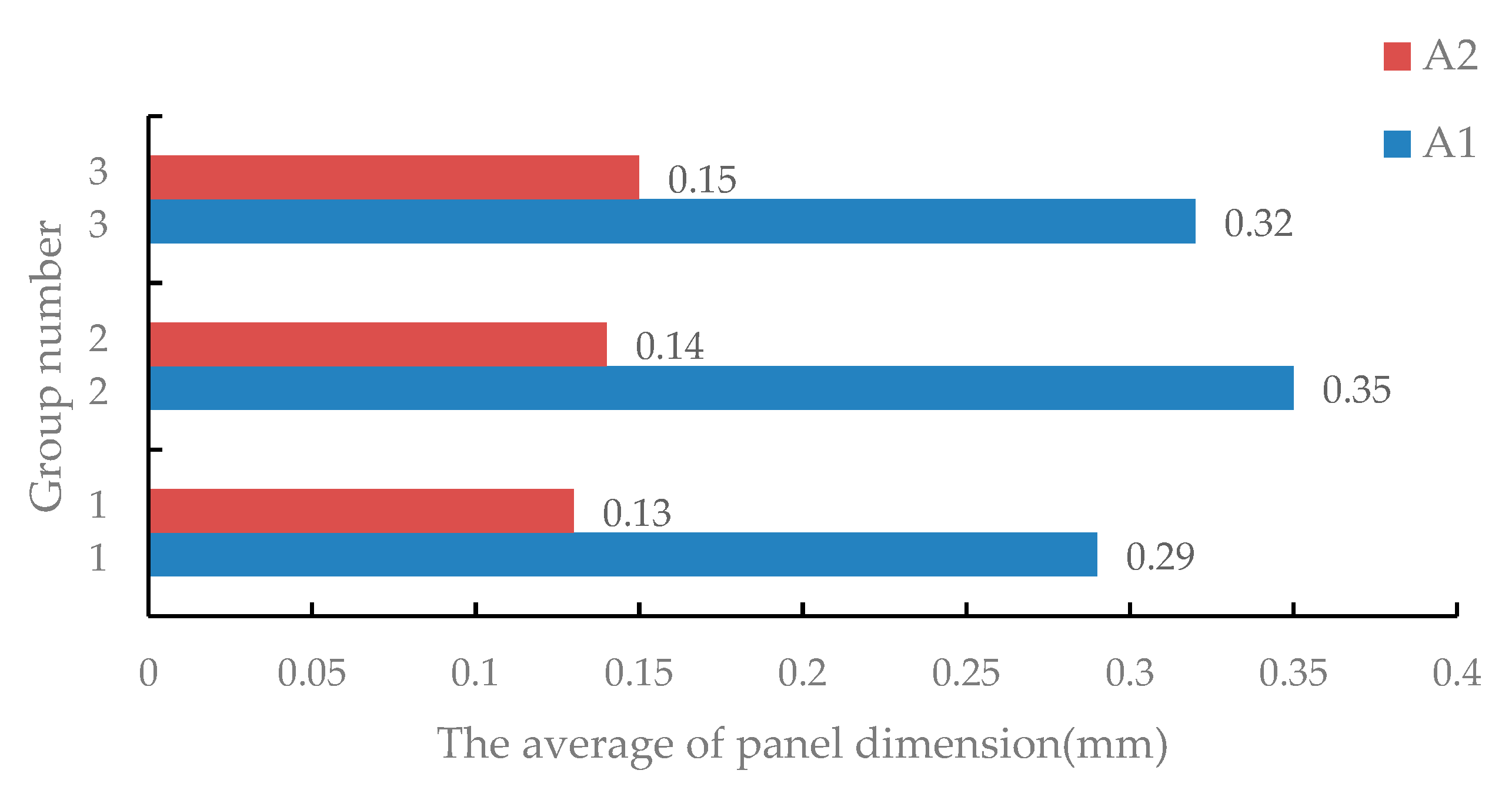
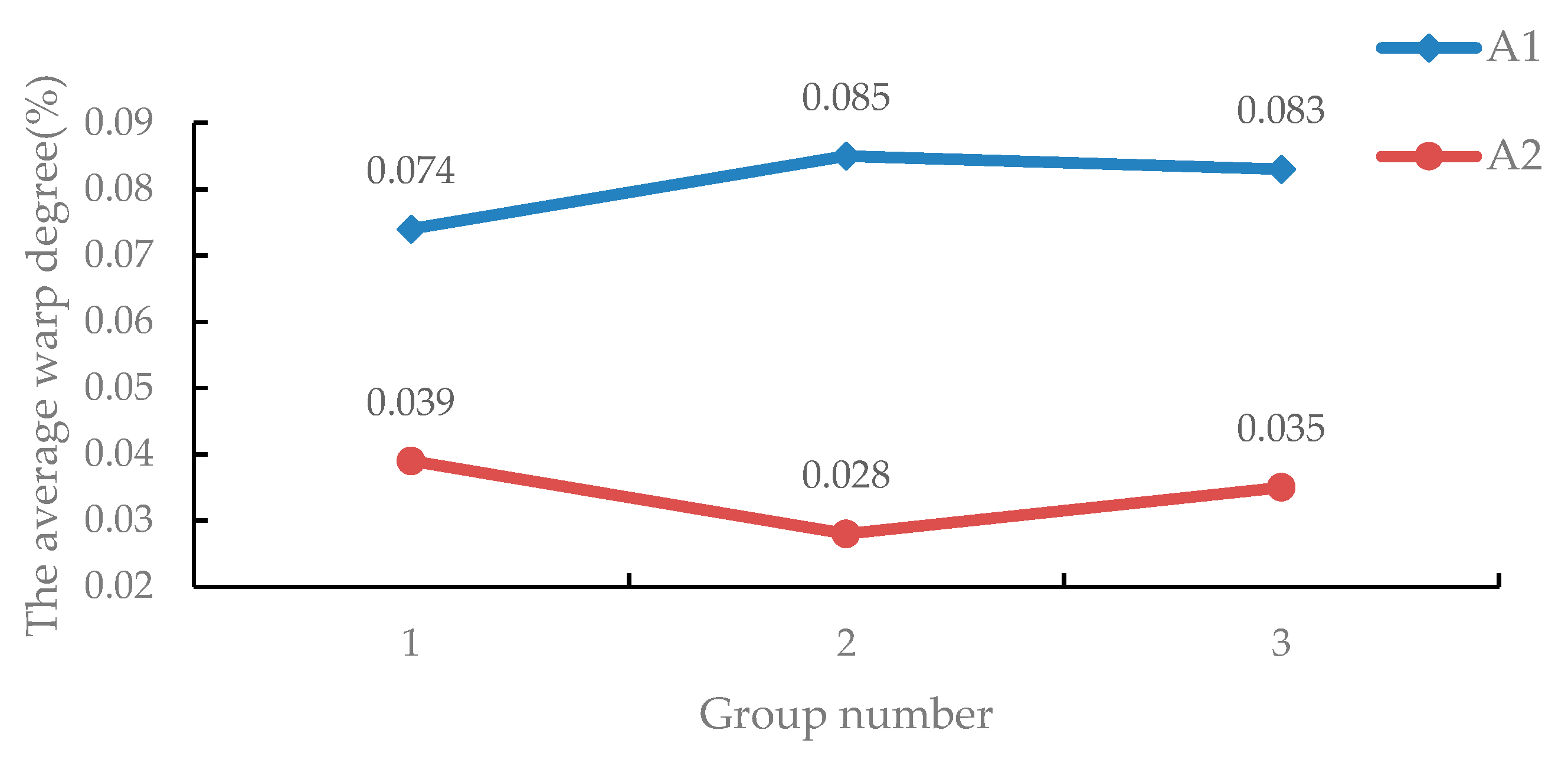
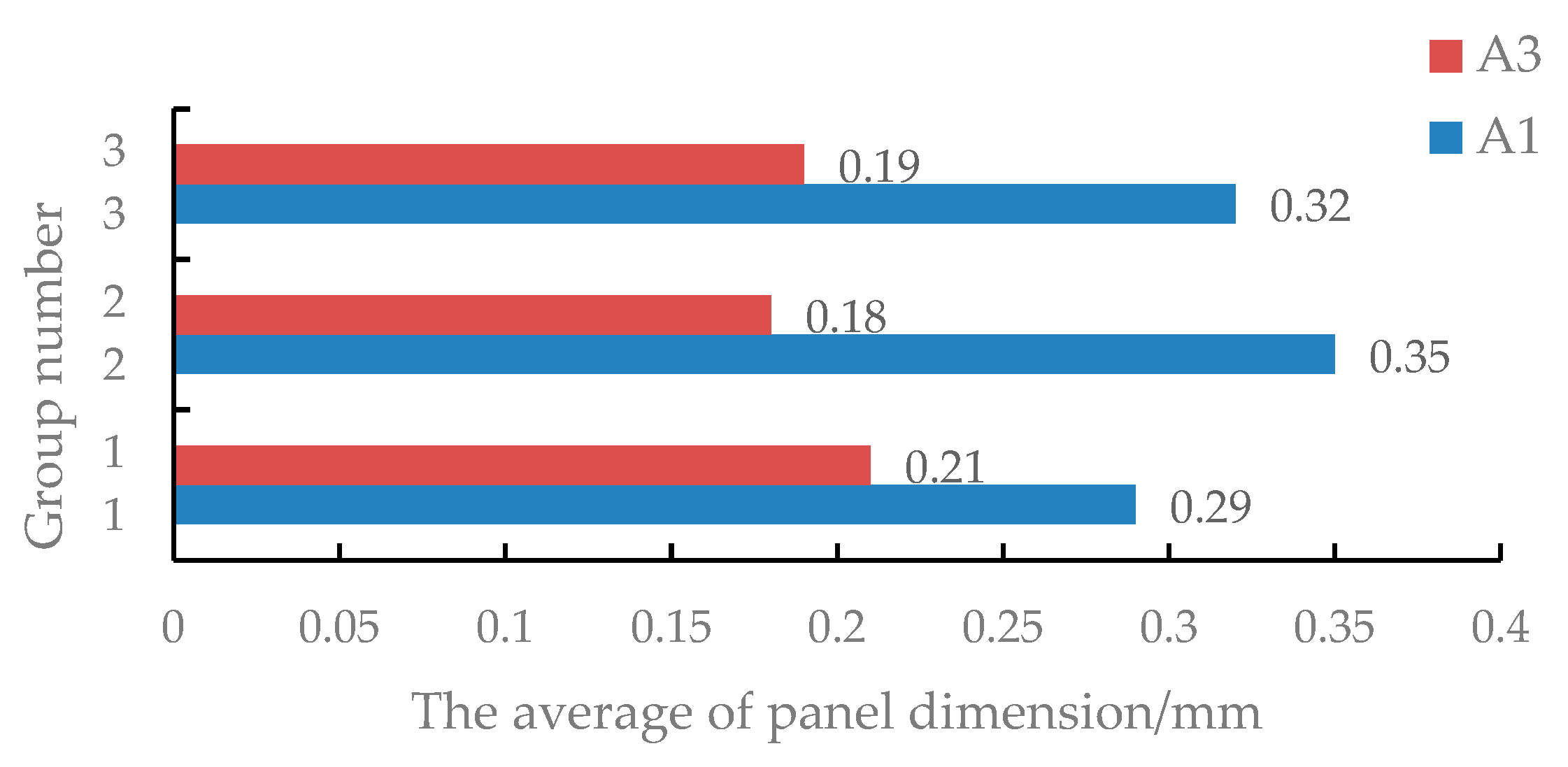
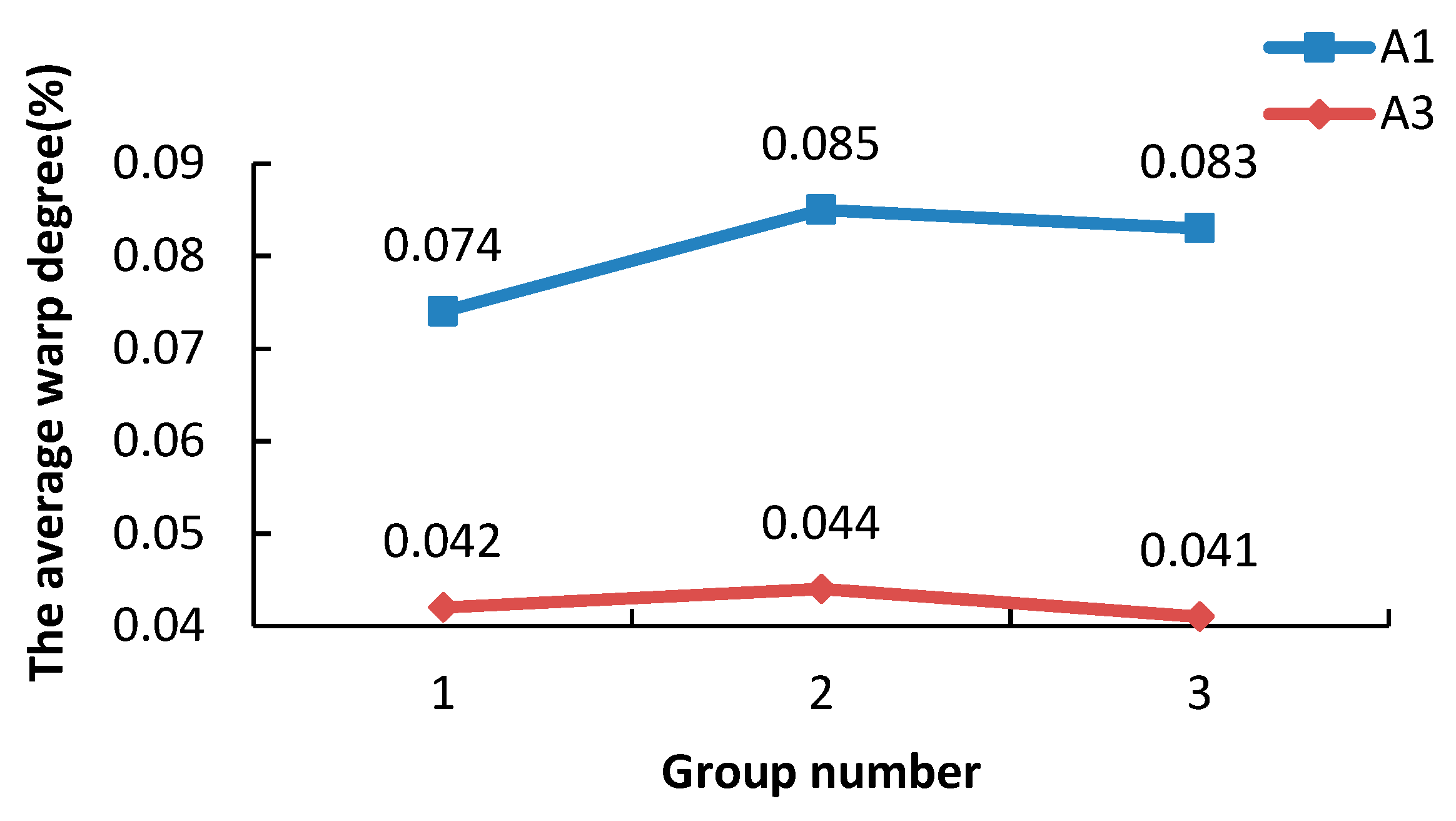
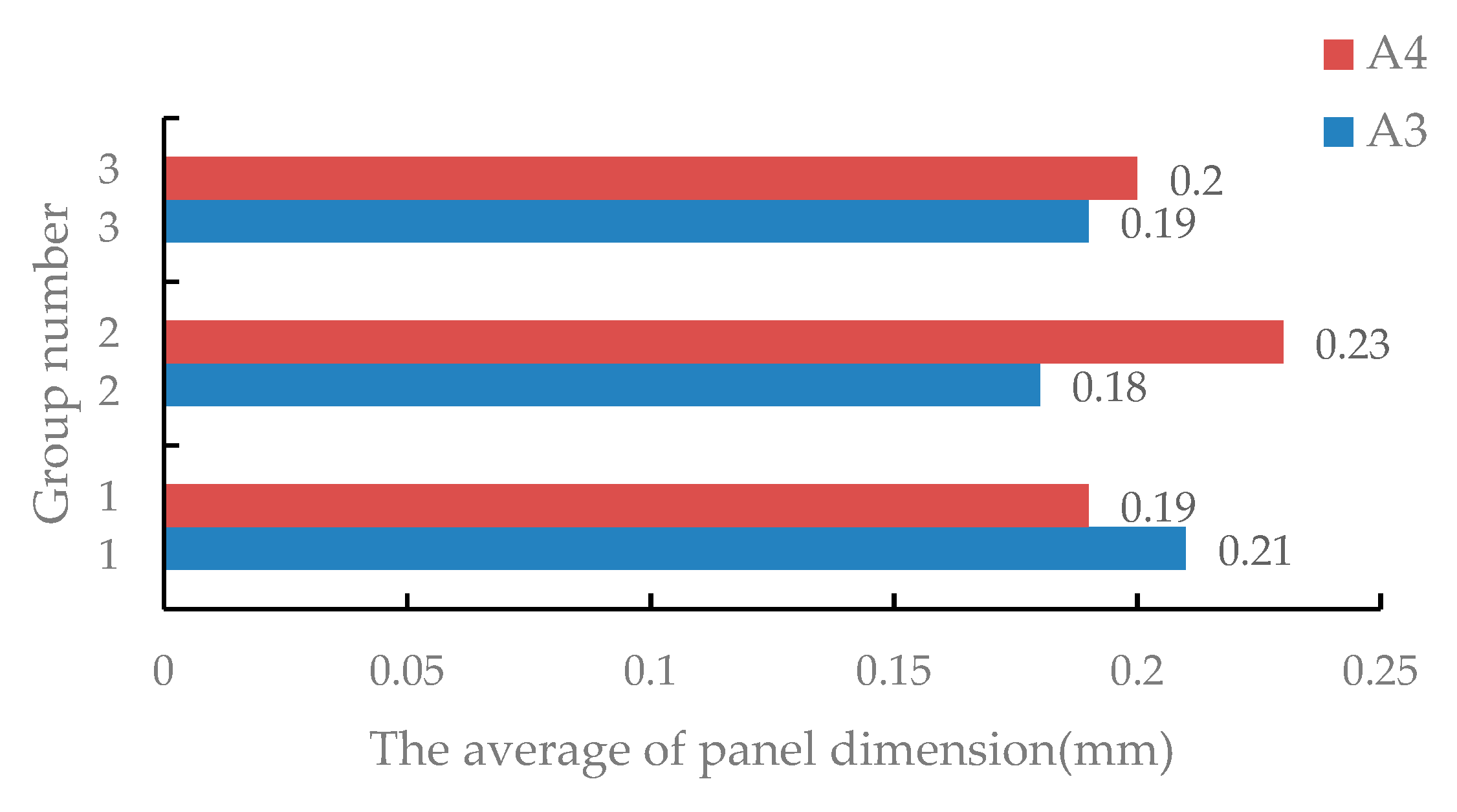
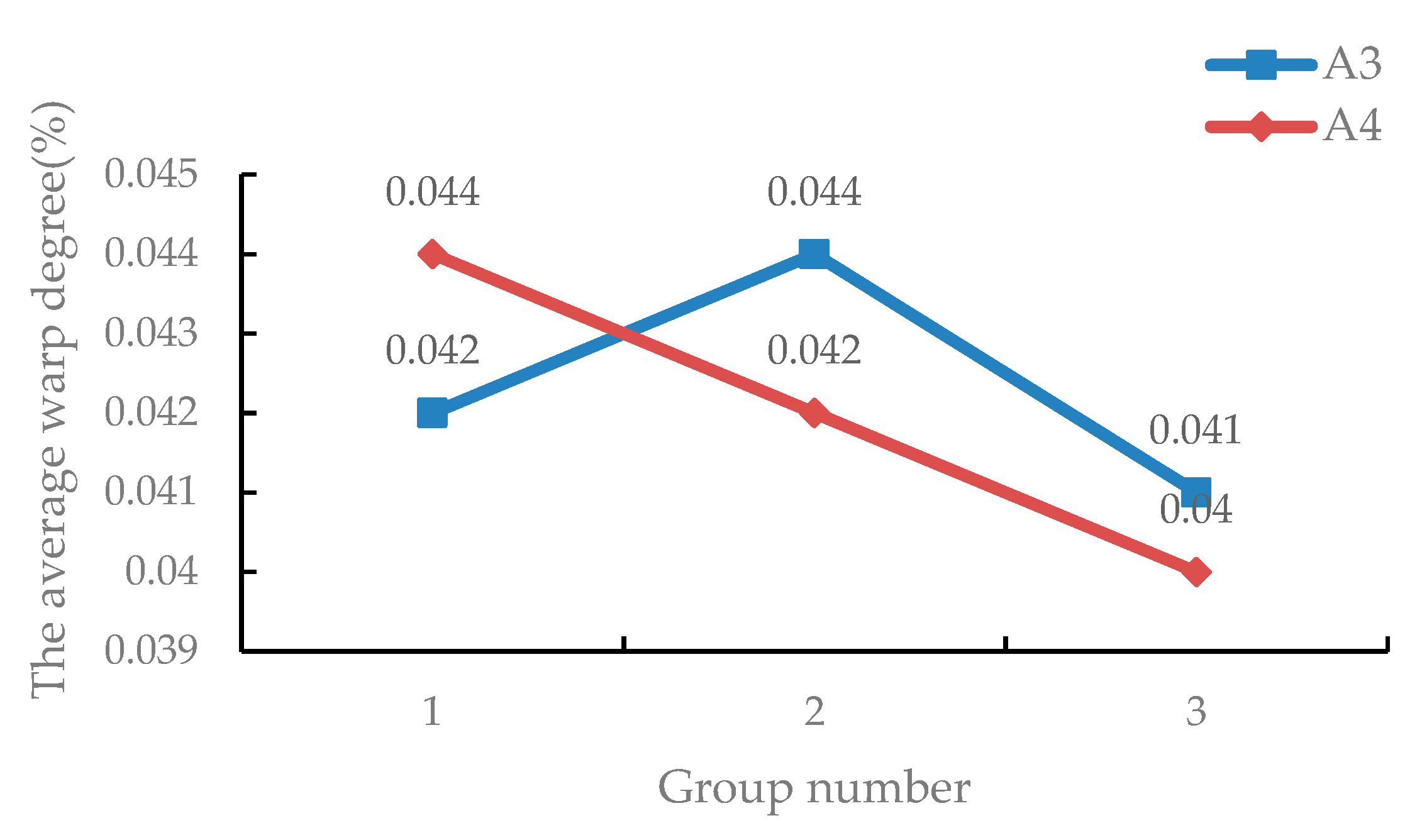
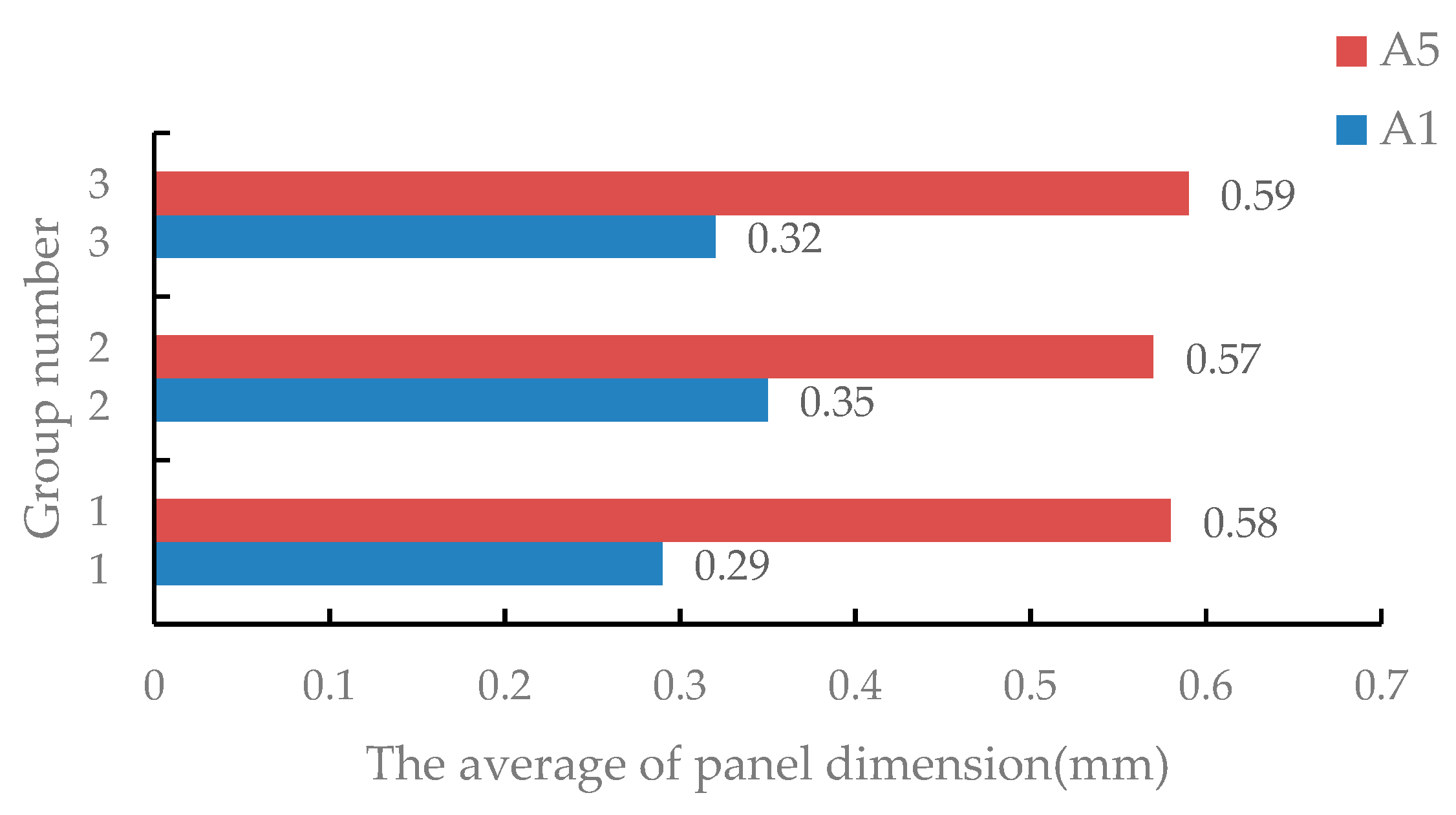
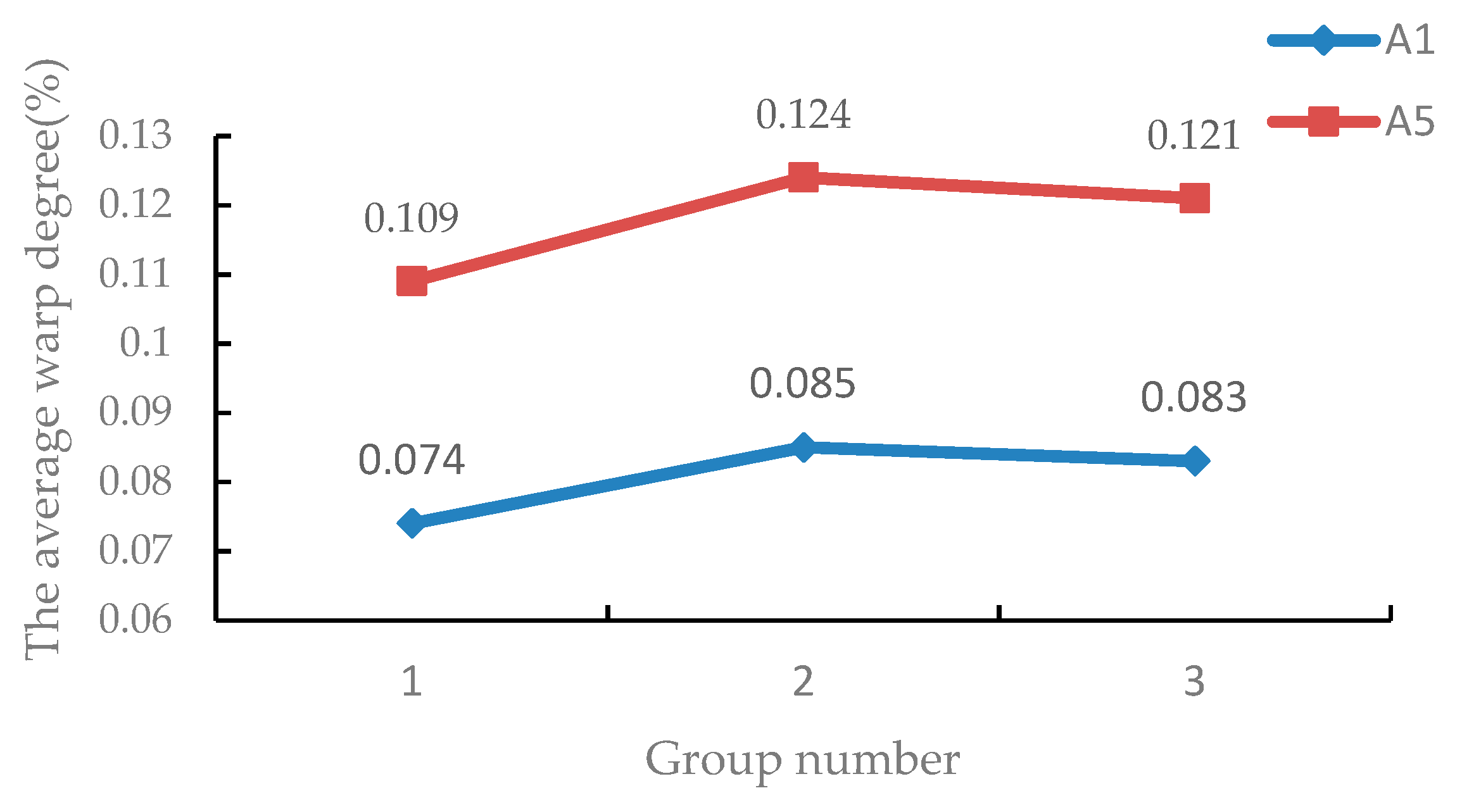
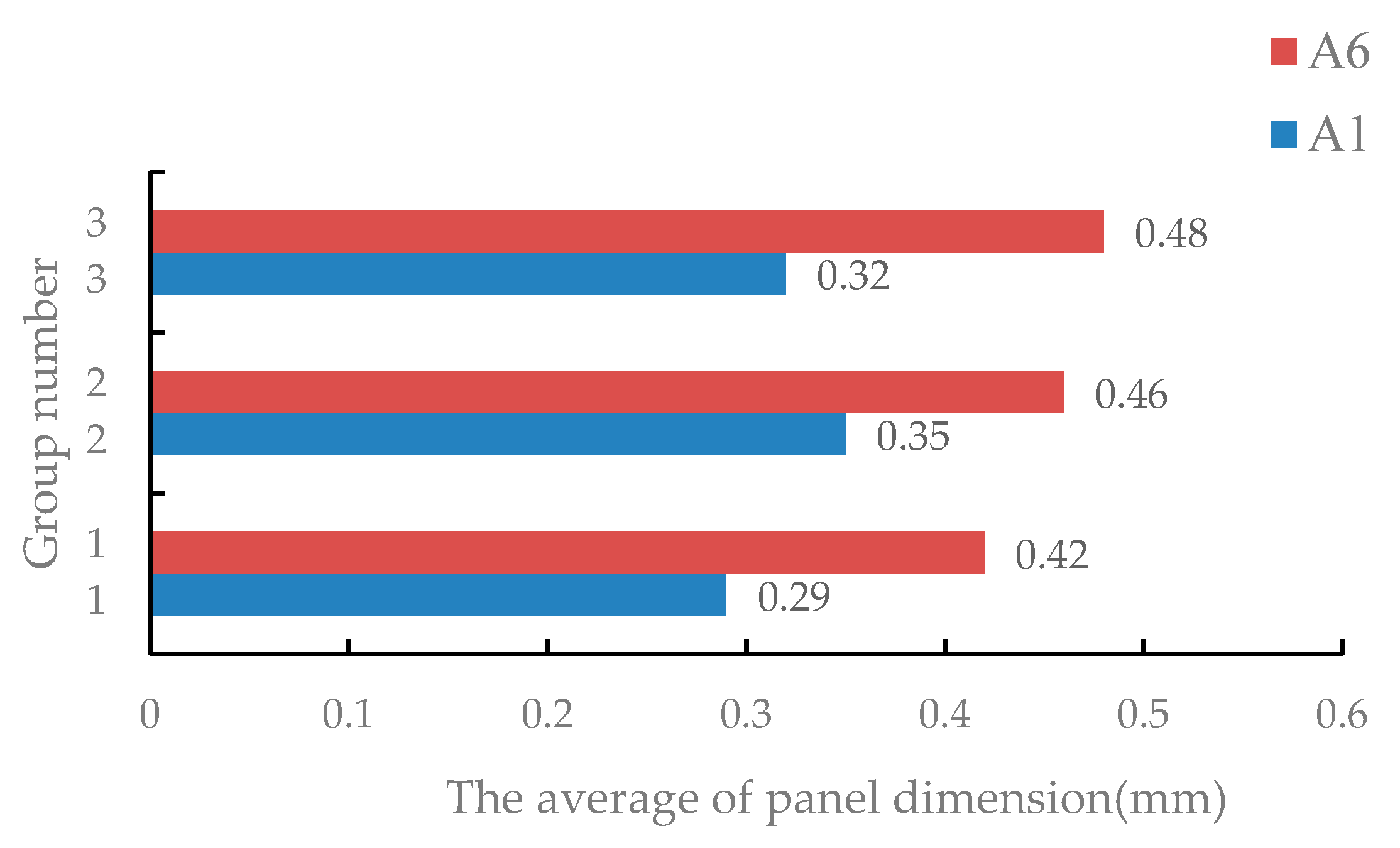
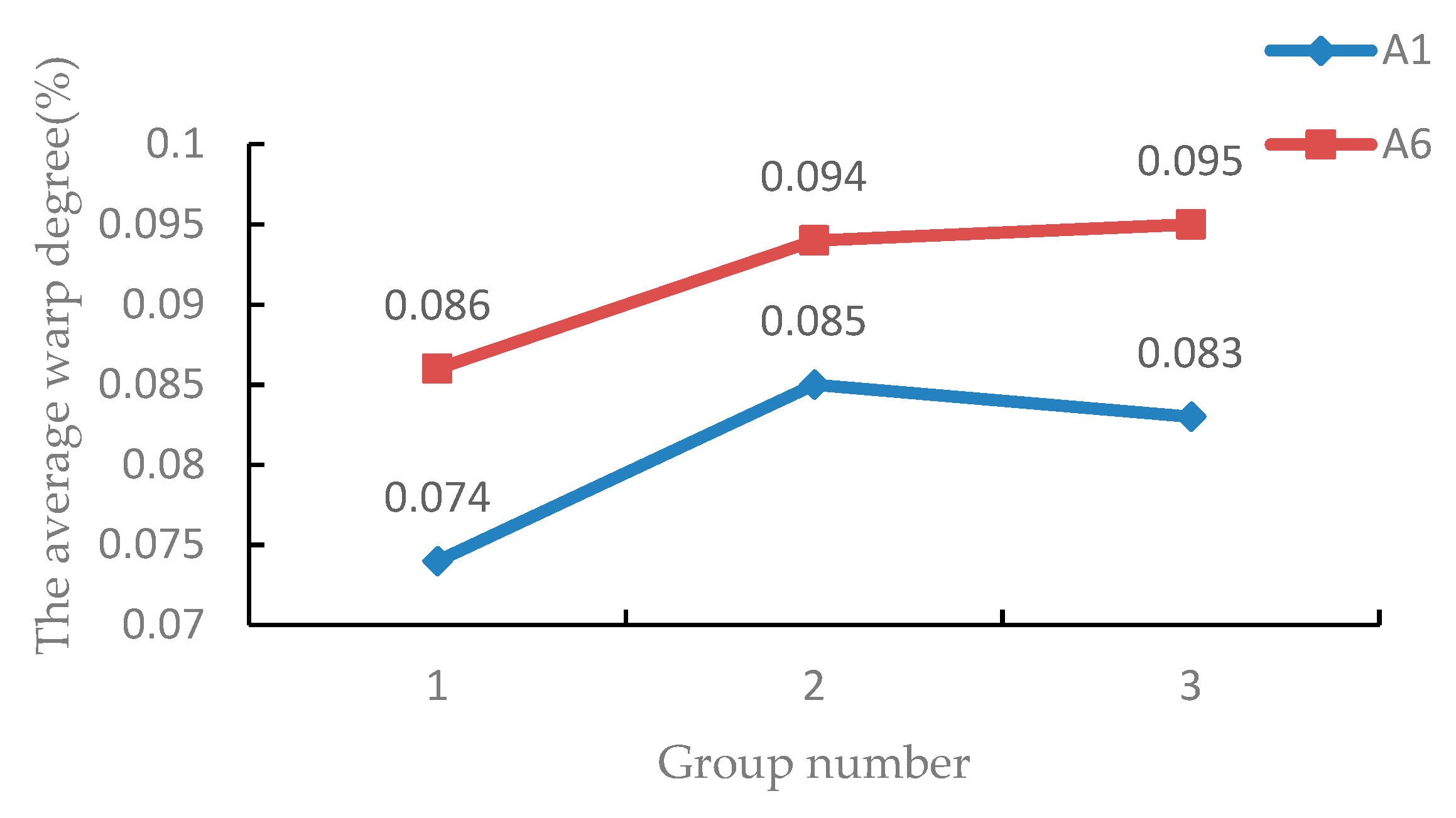
| Parameter | Value |
|---|---|
| Sandpaper grit size | 600 # |
| Aging time of coating | 2–3 min |
| Pressing temperature | 80 °C |
| Pressing time | 90 s |
| Aging time of veneering | 8–24 h |
| Group Number | Moisture Content of RSP (%) | Sanding Thickness of RSP (mm) | Glue Spread (g/m2) | Veneer Species | Veneer Thickness (mm) |
|---|---|---|---|---|---|
| A1 | 10.2 | 0.2 | 80 | Betula sp. | 0.8 |
| A2 | 10.2 | 0.6 | 80 | Betula sp. | 0.8 |
| A3 | 10.2 | 0.2 | 80 | Cyclobalanopsis glauca | 0.8 |
| A4 | 8.5 | 0.2 | 80 | Cyclobalanopsis glauca | 0.8 |
| A5 | 10.2 | 0.2 | 150 | Betula sp. | 0.8 |
| A6 | 10.2 | 0.2 | 80 | Betula sp. | 0.28 |
| Group Number | Dimension Deviation of Length (mm) | Dimension Deviation of Width (mm) | Dimension Deviation of Diagonal (mm) | Dimension Deviation of Average Value (mm) | |
|---|---|---|---|---|---|
| A1 | 1 | 0.30 | 0.26 | 0.30 | 0.29 |
| 2 | 0.34 | 0.38 | 0.32 | 0.35 | |
| 3 | 0.32 | 0.30 | 0.34 | 0.32 | |
| A2 | 1 | 0.12 | 0.14 | 0.14 | 0.13 |
| 2 | 0.14 | 0.12 | 0.16 | 0.14 | |
| 3 | 0.14 | 0.16 | 0.14 | 0.15 | |
| A3 | 1 | 0.22 | 0.18 | 0.24 | 0.21 |
| 2 | 0.18 | 0.16 | 0.20 | 0.18 | |
| 3 | 0.16 | 0.20 | 0.20 | 0.19 | |
| A4 | 1 | 0.20 | 0.16 | 0.22 | 0.19 |
| 2 | 0.24 | 0.22 | 0.24 | 0.23 | |
| 3 | 0.18 | 0.22 | 0.20 | 0.20 | |
| A5 | 1 | 0.58 | 0.56 | 0.60 | 0.58 |
| 2 | 0.54 | 0.58 | 0.58 | 0.57 | |
| 3 | 0.60 | 0.56 | 0.62 | 0.59 | |
| A6 | 1 | 0.40 | 0.44 | 0.41 | 0.42 |
| 2 | 0.43 | 0.47 | 0.47 | 0.46 | |
| 3 | 0.50 | 0.46 | 0.49 | 0.48 | |
| Group Number | Length (%) | Width (%) | Diagonal (%) | Average Value (%) | |
|---|---|---|---|---|---|
| A1 | 1 | 0.076 | 0.069 | 0.077 | 0.074 |
| 2 | 0.084 | 0.087 | 0.085 | 0.085 | |
| 3 | 0.083 | 0.079 | 0.086 | 0.083 | |
| A2 | 1 | 0.031 | 0.043 | 0.044 | 0.039 |
| 2 | 0.028 | 0.026 | 0.031 | 0.028 | |
| 3 | 0.033 | 0.035 | 0.036 | 0.035 | |
| A3 | 1 | 0.041 | 0.044 | 0.042 | 0.042 |
| 2 | 0.044 | 0.041 | 0.047 | 0.044 | |
| 3 | 0.040 | 0.043 | 0.039 | 0.041 | |
| A4 | 1 | 0.043 | 0.046 | 0.043 | 0.044 |
| 2 | 0.039 | 0.041 | 0.045 | 0.042 | |
| 3 | 0.037 | 0.041 | 0.042 | 0.040 | |
| A5 | 1 | 0.114 | 0.097 | 0.117 | 0.109 |
| 2 | 0.125 | 0.118 | 0.129 | 0.124 | |
| 3 | 0.126 | 0.113 | 0.123 | 0.121 | |
| A6 | 1 | 0.083 | 0.087 | 0.087 | 0.086 |
| 2 | 0.092 | 0.094 | 0.097 | 0.094 | |
| 3 | 0.096 | 0.093 | 0.095 | 0.095 | |
© 2020 by the authors. Licensee MDPI, Basel, Switzerland. This article is an open access article distributed under the terms and conditions of the Creative Commons Attribution (CC BY) license (http://creativecommons.org/licenses/by/4.0/).
Share and Cite
Xiong, X.; Niu, Y.; Yuan, Y.; Zhang, L. Study on Dimensional Stability of Veneer Rice Straw Particleboard. Coatings 2020, 10, 558. https://doi.org/10.3390/coatings10060558
Xiong X, Niu Y, Yuan Y, Zhang L. Study on Dimensional Stability of Veneer Rice Straw Particleboard. Coatings. 2020; 10(6):558. https://doi.org/10.3390/coatings10060558
Chicago/Turabian StyleXiong, Xianqing, Yiting Niu, Yingying Yuan, and Liangting Zhang. 2020. "Study on Dimensional Stability of Veneer Rice Straw Particleboard" Coatings 10, no. 6: 558. https://doi.org/10.3390/coatings10060558
APA StyleXiong, X., Niu, Y., Yuan, Y., & Zhang, L. (2020). Study on Dimensional Stability of Veneer Rice Straw Particleboard. Coatings, 10(6), 558. https://doi.org/10.3390/coatings10060558




